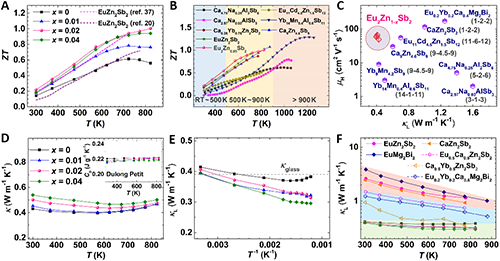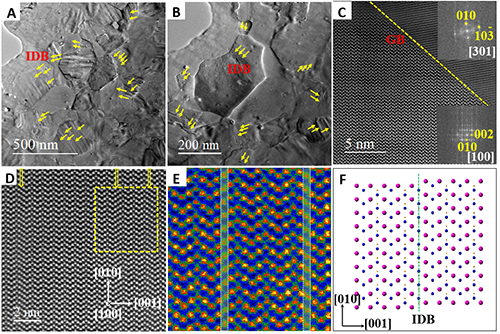
Zintl compounds are considered to be potential thermoelectric materials due to their "phonon glass electron crystal" (PGEC) structure. The dimensionless figure-ofmerit ZT is usually used to describe the thermoelectric performance.
Among the parameters related ZT value, the lattice thermal conductivity is the only independent material property. A straightforward way for achieving high thermoelectric performance is to searching for compounds with intrinsic complex structure and low lattice thermal conductivity.
The Zintl phase is a prototype of the PGEC concept. To date, among the Zintl phases with excellent thermoelectric properties, 1-2-2–type Zintl compounds (EuZn2Sb2, CaZn2Sb2, YbZn2Sb2, YbCd2Sb2, etc.) have been the most widely investigated.
Recently, researchers led by Dr. WANG Yumei from Institute of Physics, Chinese Academy of Sciences have teamed up with Prof. ZHANG Qian from Harbin Institute of Technology, Shenzhen, discovered a promising Zintl-phase thermoelectric material, 2-1-2–type Eu2ZnSb2 (P63/mmc).
Compared with the 1-2-2 type Zintl thermoelectric materials, Eu2ZnSb2 has very low lattice thermal conductivity. And the ZT value is higher than that of some previous reported Zintl-phase.
The excellent thermoelectric performance of Eu2ZnSb2 is considered to be related with its microstructure.
Scanning transmission electron microscopy (STEM) is a powerful technique to study the crystal structure and defects at atomic level.
After studying the microstructure of the Eu2ZnSb2 using the Cs corrected STEM, the researchers found Eu2ZnSb2 has the external Eu atomic layers inserted in the [Zn2Sb2]2- network compared to the structure of 1-2-2–type EuZn2Sb2.
The external Eu atomic layers act as the phonon scattering center, leading to the anomalous low total thermal conductivity.
In addition, there are many planar defects in the Eu2Zn0.98Sb2 sample. From the STEM image, these defects are determined to be the inversion domain boundaries (IDB).
The widely distributed of the IDB is considered to be the main factor that reduces lattice thermal conductivity. Its intrinsic crystal structure, together with the abundant IDB in the sample results in ultralow thermal conductivity.
This discovery provides a class of Zintl thermoelectric materials applicable in the medium-temperature range.
This study entitled "Zintl-phase Eu2ZnSb2: A promising thermoelectric material with ultralow thermal conductivity" was published on PNAS.
The study was supported by the National Natural Science Foundation of China, Shenzhen Fundamental Research Projects, Startup Foundation from Shenzhen, and Startup Foundation from Harbin Institute of Technology (Shenzhen).

Fig. 1 Structure characterizations of the Eu2ZnSb2 Zintl phase. (Image by Harbin Institute of Technology, Shenzhen and Institute of Physics)

Fig. 2 Comparison of ZT values and lattice thermal conductivity. (Image by Harbin Institute of Technology, Shenzhen)

Fig. 3 Typical microstructures for Eu2Zn0.98Sb2. (Image by Institute of Physics)

86-10-68597521 (day)
86-10-68597289 (night)

52 Sanlihe Rd., Xicheng District,
Beijing, China (100864)

